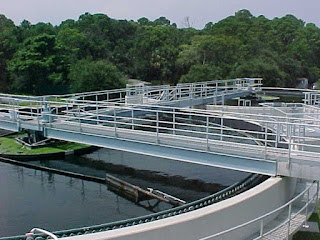Recycling Gone to Pot?
 |
| Wastewater treatment plant clarifiers |
Our resources are limited. So reusing things makes sense. Glass, paper, metal.
And water, of course. After 36 years in the water business, I can tell you that water is our most precious resource.
And it's very expensive to treat, pump, distribute to each home, and clean up the wastewater.
Most wastewater plants are now called water reclamation facilities--because at least part of the treated effluent receives further treatment so it can be recycled.
Reclaimed water irrigates golf courses and residential lawns, agricultural crops and football fields. It's used in industrial cooling towers and boilers. Disney World even uses reclaimed water to wash buses. So, recycling water is commonplace.
 |
| Reclaimed water irrigating golf course turf |
But I came across an article in my Water Environment Federation Highlights newsletter where the University of Michigan and the Rich Earth Institute are taking things a step further.
They're conducting research, funded by the U.S. Environmental Protection Agency (EPA) through the Water Environment Research Foundation to study how disinfected human urine can be recycled to fertilize crops.
Yes - on April 1, 2016, the University of Michigan, College of Engineering held its first Pee-Cycling event to collect samples.
Why? Because urine contains the nutrients (nitrogen and phosphorus) used to grow crops, and it's easier to extract directly from pee vs. the much diluted wastewater effluent. (Wastewater is 99.9% pure water).
The researchers are also determining if and how residual pollutants, like pharmaceuticals, will affect the crops or groundwater.
It's a very interesting experiment, but if successful, I'm sure it will take a lot of public outreach to get widespread support.
However, the "urine drive" at the university was very successful!



Comments
Post a Comment